A few weeks ago I bookmarked the article 21 things related to SEO and was blown away by how much I learned. So I tracked down “Backlinko” as he’s known online, aka Brian Dean, and read almost all of his amazing content. His stuff was pure gold so I traded him 50 bratwursts and some beers (he lives in Berlin) for him to share this post.
Buckle up. You’re in for a ride.
* * *
I think you’ll agree with me when I say:
Getting your content to stand out today is HARD.
In fact, according to one source, there are over 2 million blog posts published every single day[1].
In other words, when you hit your WordPress “publish” button, you’re one of 1,999,999 other people doing the exact same thing.
Despite the intense competition, you may have noticed that certain people are able to generate hundreds of Tweets, backlinks and visitors to everything that they put out there.
If you’ve ever wondered “how do they do that?”, you’re in for a real treat.
Because today I’m going to pull back the curtain and show you EXACTLY how to write (and promote) a piece of content that generates thousands of laser-targeted visitors to your site.
Let’s do this.
The Secret To Content That Gets Results in 2017 (and Beyond)
I launched my SEO blog, Backlinko, in January 2013.
Today my blog is one of the most popular marketing blogs in the world (Forbes recently called Backlinko one of the top 25 “blogs to follow” in 2017). It also generates over 150,000 unique visitors per month:
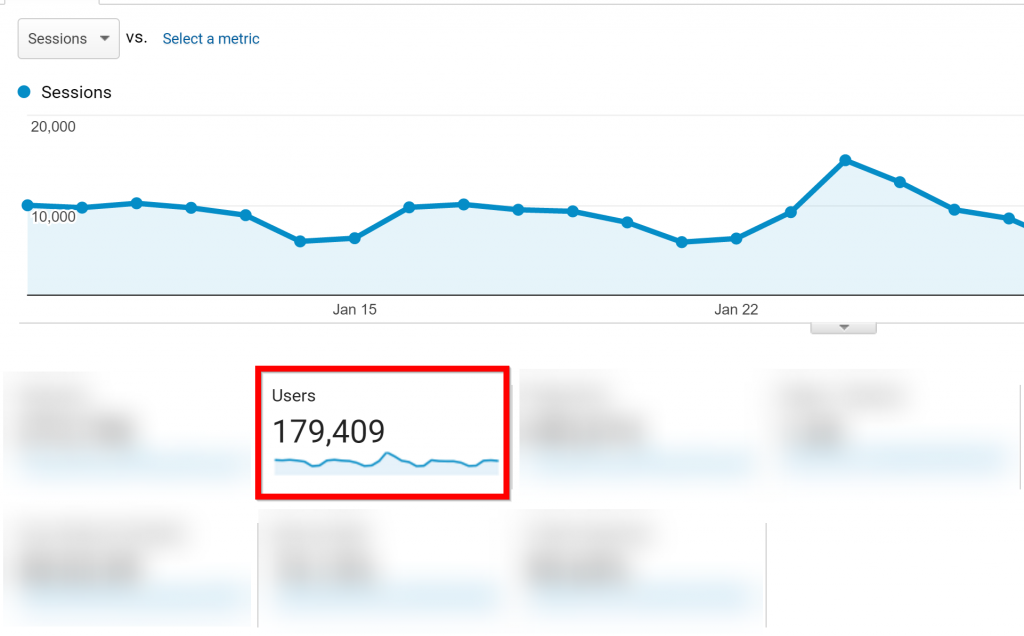
But things didn’t always go so swimmingly for me…
Because Backlinko was my first blog, I started out by devouring as much blogging advice as I could get my hands on.
Good idea, right?
Well, actually….no.
Unfortunately, most of the advice from so-called blogging “experts” is pure crap.
Here’s what my traffic looked like when I followed their BS advice, like “publish every week” and “write list posts”:

That’s literally 4-months of my banging my head against a wall wondering why no one read my blog.
(You may not be able to see it in that screenshot, but I was averaging about 30 unique visitors per day. Not good.)
Fortunately, my story doesn’t end there.
Here’s what happened next…
How Reverse Engineering Saved My Blog
Needless to say, I was frustrated, discouraged (and as hard as this is to admit), close to giving up.
That’s when I decided to step outside of the “blogging about blogging” world and do something that I should have done from day 1: Study successful blogs in my niche.
In other words, reverse engineering.
And when I used their proven approach as my framework, my traffic shot up like a rocket:
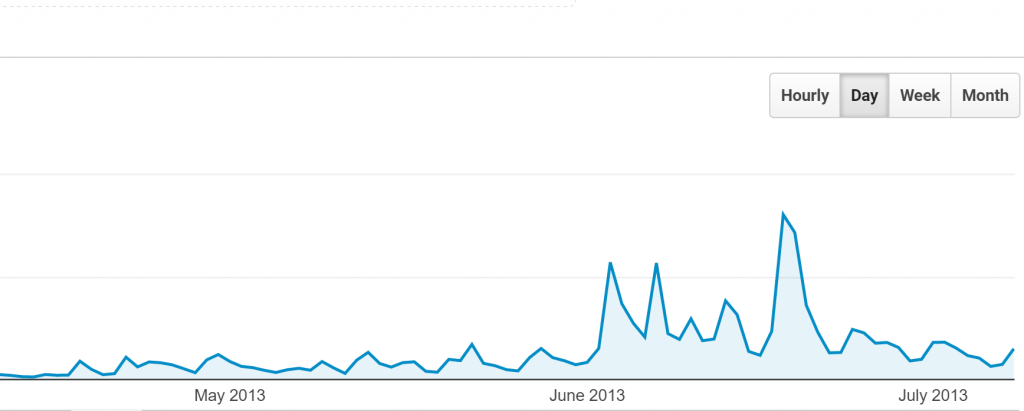
Now it’s time to show you the step-by-step process I used to turn things around…
…and how you can tap into the same approach to get more traffic to your blog.
A Proven Framework For Successful Content
If you’re serious about getting more traffic to your site, then you want to tattoo this 3-step formula on your forehead:
Step #1: Find content (in the form of blog posts, guides, infographics and videos) in your niche that has already done well.
Step #2: Take what you find and make it even better.
Step #3: Promote your content directly to people that would be interested in it.
I call this nifty little system The Skyscraper Technique.
It’s as old school as blowing in Nintendo cartridges. But it works today…
…and will work as long as people publish content online.
Let’s jump right in.
(I created a simple Google Doc spreadsheet for you that you can use to keep track of things. Here you go)
Step #1: Find Successful Content In Your Niche
Most blogs struggle to get readers for one simple reason:
They publish content that they think will work.
I’ve actually heard bloggers say, “If I publish enough stuff, something will go viral and I’ll be set”.
#facepalm
As you’ve seen, that approach didn’t work out very well for me.
What should you do instead?
Find something that’s already proven to work.
Here’s how:
Wikipedia
You might be wondering how boring Wikipedia articles will help you find killer content ideas…
Sure, the Wikipedia entries themselves aren’t going to get your creative juices flowing. But the references are a completely different story.
Why?
You KNOW that if a piece of content gets cited as a reference in Wikipedia, that it must have been popular (after all, an editor had to be aware of its existence for him or her to include it).
First, head over to Wikipedia and enter a broad-ish search term. So if you have a blog about weight loss, you want to use keywords like “fitness”, “nutrition” and “exercise”.
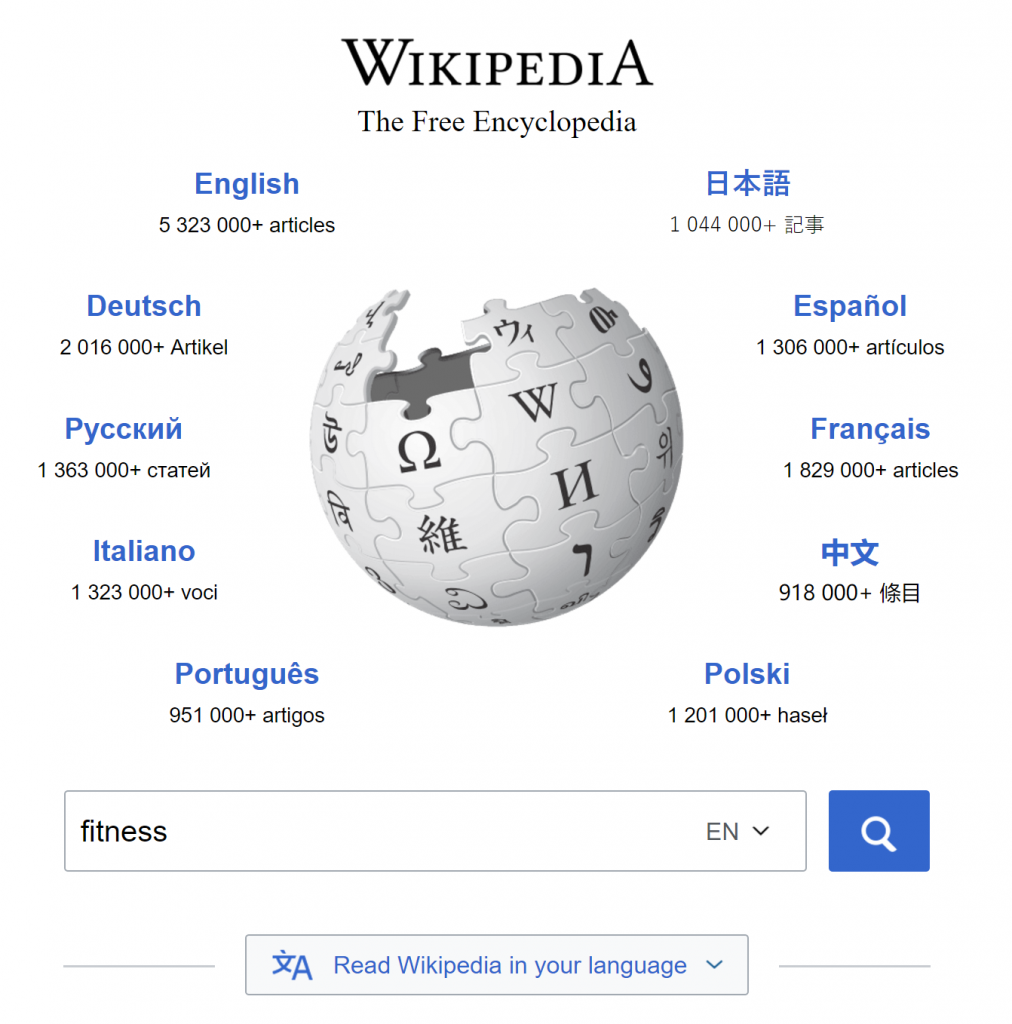
The references in these super-broad topic Wikipedia entries won’t be much use to you (they’re usually links to academic papers and books).
These topics usually have a list of links to other Wikipedia entries that will have references that you can tap into:
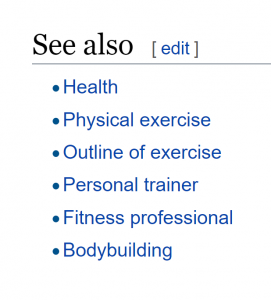
For example, I found 5 blog posts and articles (in other words, not scientific research papers) cited in the Wikipedia entry for “Strength Training”.
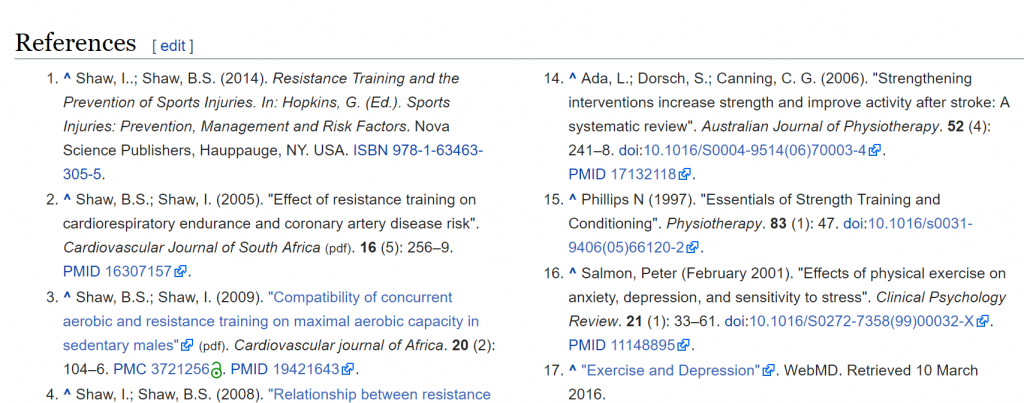
At least 3 out of the 5 would make great blog post topics:
- “Strength training sets: How many for best results?”
- “The Metabolism Myth: There’s no biologic reason to get fatter as you grow older”
- “The Rest-Pause method of bodybuilding”
And that’s just from ONE Wikpedia entry. If you spend 15-minutes with this strategy you’ll walk away with even more proven topics.
Reddit may seem a hipster hangout where bored people waste time by leaving comments on cat gifs…OK, maybe that describes Reddit pretty well 🙂
But Reddit is so much more than that…
In fact, it’s an absolute gold mine for blog post topic ideas.
Here’s how to use it:
First, find a subreddit that covers what you tend to write about. Because Reddit’s search leaves a lot to be desired, I recommend using SearchReddit.com instead:

If there’s a subreddit on that topic — which thereusually is — head over to it. If not, just check out threads that discuss your blog’s niche.
By default, subreddits rank threads based on what’s popular at that moment.
If you’re in a niche with a lot of big news (ie. SEO), then it makes sense to spend some checking out trending topics. But most niches don’t have breaking news every week.
For example, the dog training subreddit’s front page didn’t hook me up with many topics that I could actually use:

So if you don’t see anything promising on the front page, click on the “top” tab.

This will show you the all-time most popular threads in that subreddit:
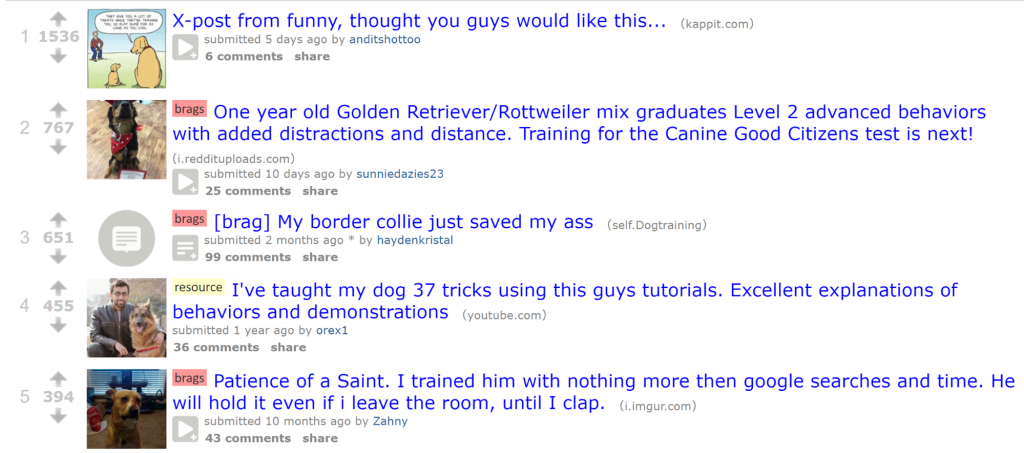
The all-time best threads handed me a bunch of awesome topics that had a track record of doing well (based on Reddit upvotes):
- “7 Mistakes You’re Making in Behavior Modification”
- “A list of urban agility tricks to teach your dog to make walks *way* more fun”
- “Does Your Dog REALLY Want to be Petted? Consent Test”
- “How to Be a Kid Dogs Feel Safe with: tips for teaching kids how to build bonds safely with dogs”
Content Curators
Why spend hours hunting for content ideas when you can have other people do the heavy lifting for you?
Thanks to the rising popularity of content curation, more and more bloggers publish content that’s nothing more than a hand-groomed list of awesome content ideas.
You can find them using these search strings in Google:
best (keyword) posts
keyword + “all time best”
keyword + “best [year]”
keyword + “top 100”
keyword + “top 50”
best (keyword) posts [year]

When you do, you’ll be rewarded with a list of some of the best content from the last year (or all time):
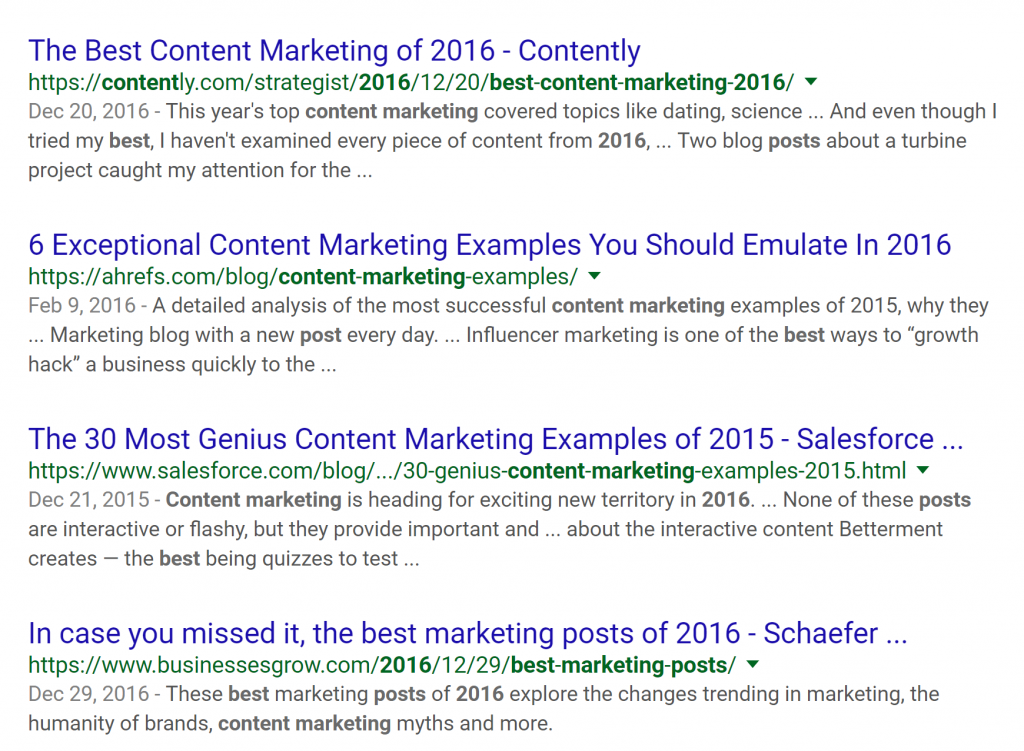
It took me about 30-seconds to find the best content marketing posts from the past year…including a few topics that I would have NEVER thought of on my own:

Easy, right?
By now you probably notice a pattern with the strategies I’ve listed so far.
What is it?
They’re resources that your competition isn’t using.
If you hang out on the same platforms as your competition (like Twitter and Facebook), you’re going to end up writing the same old stuff.
And I can guarantee that your competition completely ignores Pinterest. After all, most people think that Pinterest is nothing more than a place where mommies go to pin shoes and handbags.
That couldn’t be further from the truth. Pinterest actually drives more referral traffic than LinkedIn, YouTube and Google+ (!).
To use it for content mining, head over to the Pinterest homepage and enter a specific-ish keyword:

First, take a look at the top pins (pinterest pins are ranked my repins, comments and likes):
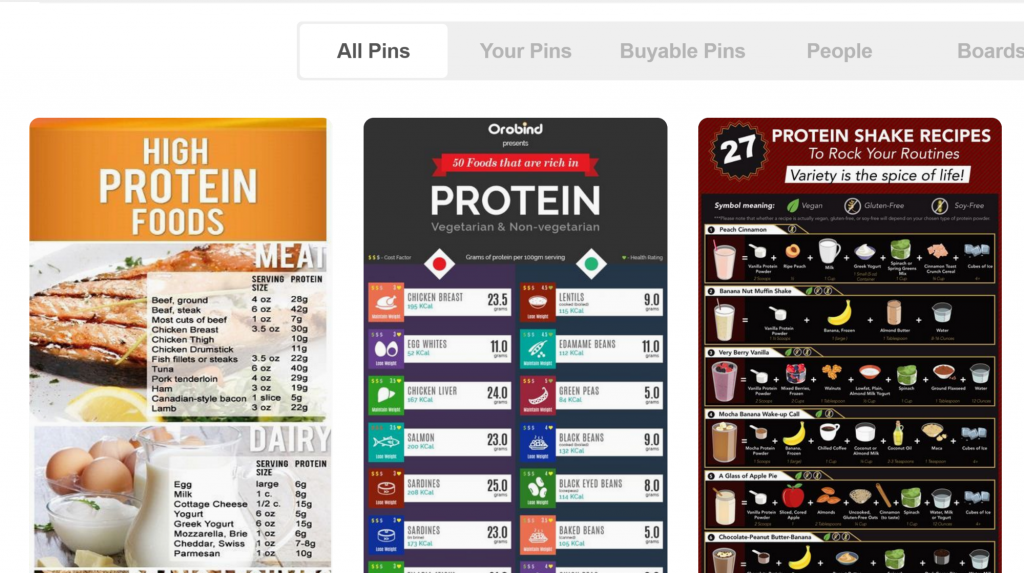
Keep an eye out for any topics that have a lot of repins:
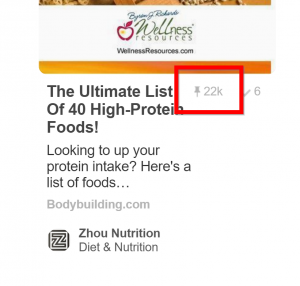
Cha-ching! Looks like there’s a lot of demand out there for a big ol’ list of high-protein foods.
Here’s another one with over 72k repins:
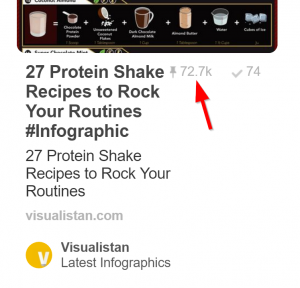
I really like this one because I would have thought that people wanted smoothie ingredients listed out like a recipe.
But I learned that people want to see the ingredients visualized. Based on this pin I’d make a post of infographic with even more visualized smoothie recipes…
…which would stand out among blog posts like, “10 healthiest smoothie recipes” or “25 best tasting smoothies for bodybuilders”.
Pinterest: you rock!
Ahrefs
Ahrefs is the world’s best backlink analysis tool.
But there’s a little-used feature that serves awesome content ideas on a silver platter: a site’s most popular pages.
First, grab a competitor’s site and enter their homepage into the tool:

We are nerdfitness fans : )
Then click on the pages → best by links. This will show you their pages that have generated the most links.
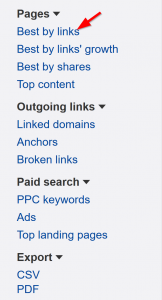
Keep an eye out for pages that have a lot of “RD’s” (Root Domains). This a fancy way of saying “the number of sites that link to that page”:
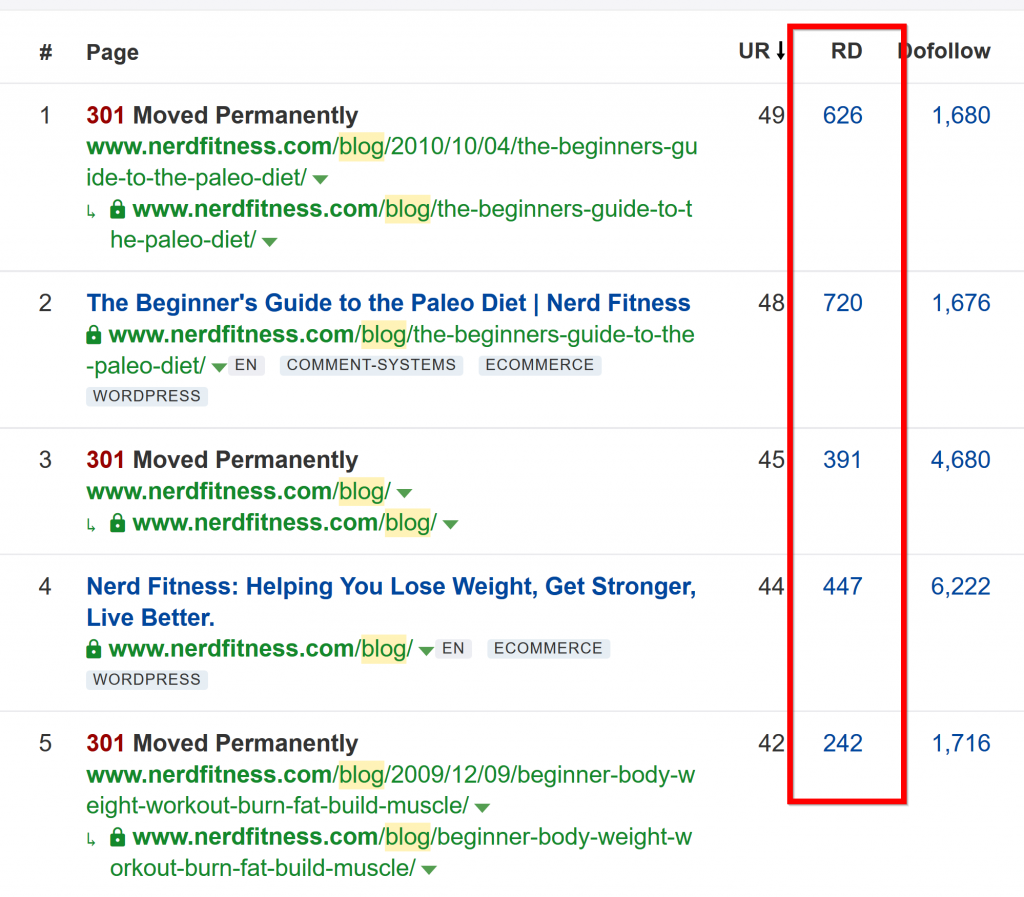
Root Domains is important because, in general, it’s MUCH harder to get a link than a tweet or Facebook like.
So when you see that’s generated 100+ links, you know that it’s a piece of content that people actually care about.
Google’s First Page
It’s not a cutting edge approach, but Google’s first page is one of the best places to find tested, proven content ideas.
So you’d be foolish to ignore it.
The Mozbar for Chrome will help you get the most from this process. This handy tool shows you the Domain Authority and Page Authority of the results on the first page.
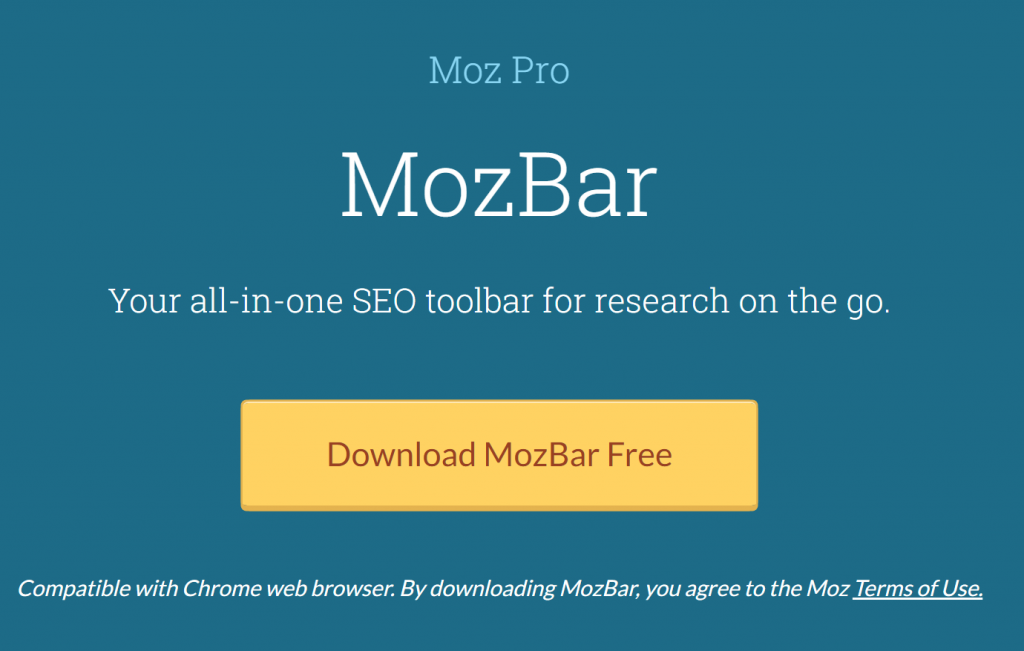
The key is to find high-ranking pages that aren’t on super authoritative domains.
You want to find pages that have a relatively high Page Authority and low Domain Authority.
That usually indicates that the content is ranking based on merit…not due to the fact that the site is run by a Fortune 500.
The Mozbar SERP overlay feature shows you the Domain and Page Authority of every result:
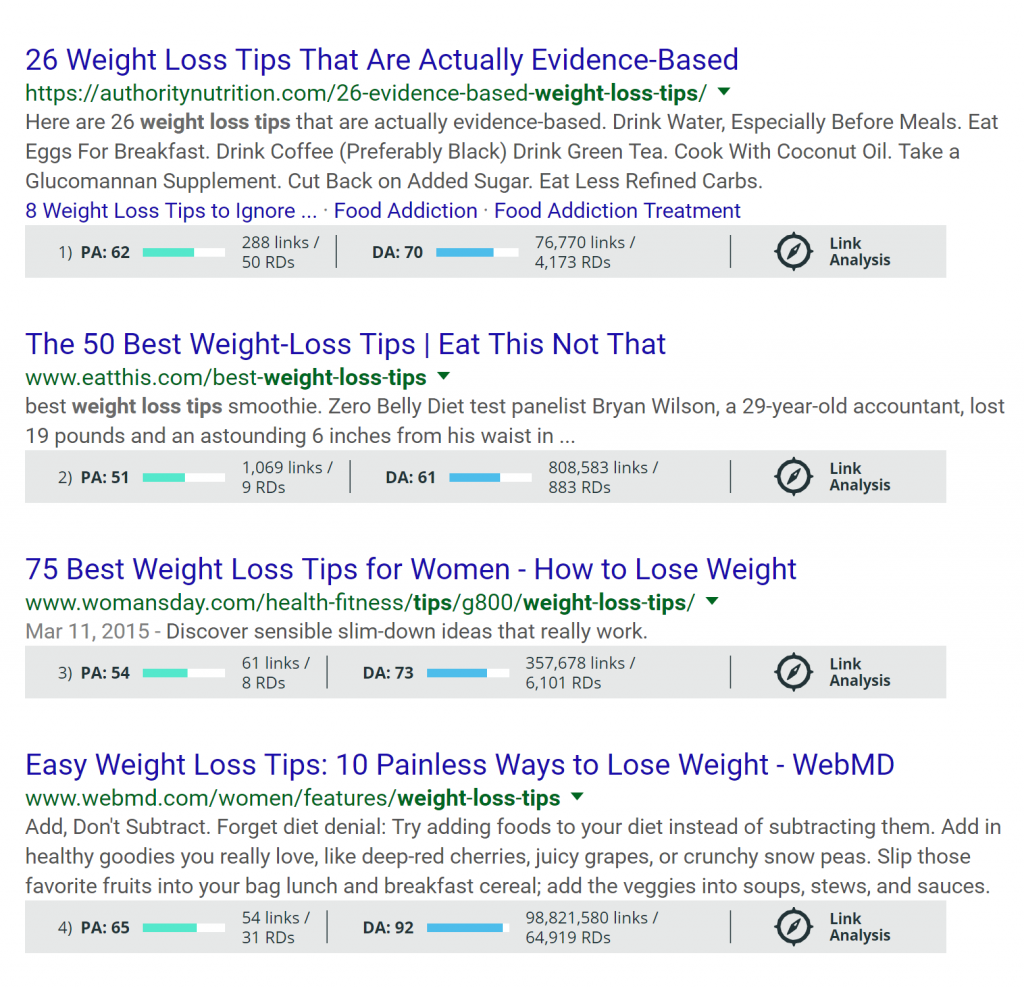
This isn’t the type of keyword you want since it’s made up of 100% big brands.
For example, let’s do a search for “best workout headphones”:

You’ll notice that a lot of the results have a high Domain Authority (above 40):

These can be content that you can take into step #2. But in general, they aren’t the best targets.
That being said, if a piece of content jumps out at you, check it out…even if it’s on an authoritative site.
Anyway, here’s an example of a site run by a mere mortal that cracked the first page for this competitive keyword:

If they can do it so can you!
That sounds cheesy, but you get the idea…
…low DA sites ranking for competitive keywords earned that spot with outstanding content. That makes them ideal for reverse engineering.
BuzzSumo
BuzzSumo is an awesome Swiss army knife of content marketing tools.
It’s most powerful feature? Its ability to find really popular content in any industry VERY quickly.
So it’s perfect for what we’re doing today.
BuzzSumo doesn’t replace the strategies I’ve outlined for you so far. But you’ll sometimes see topics in Buzzsumo that you’d otherwise miss.
So it’s worth playing around with.
First, head over to BuzzSumo.com, create an account and login. This will take you to your BuzzSumo dashboard:
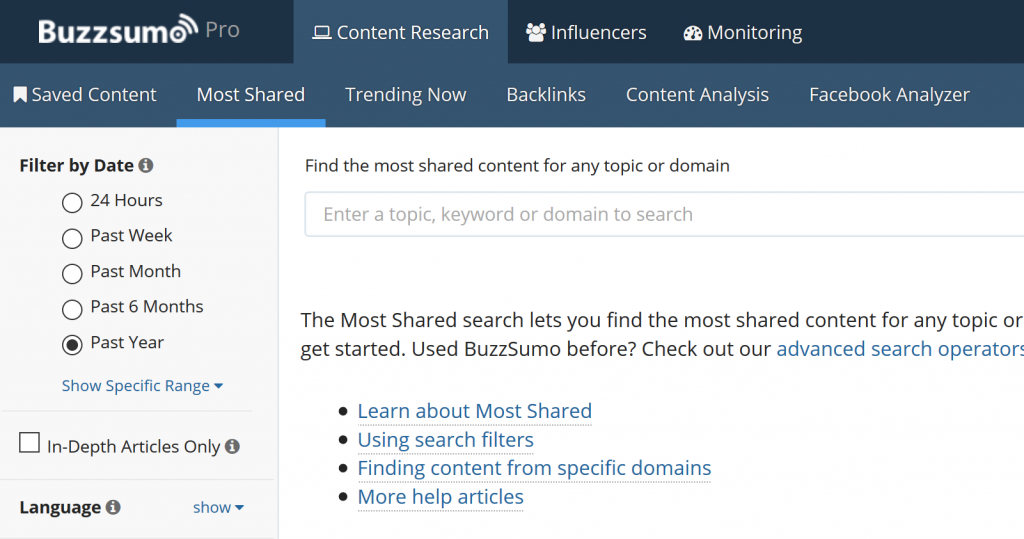
Under “Filter by Type”, uncheck everything but “article”:
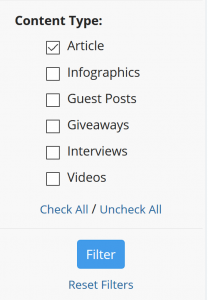
Then enter a keyword into the search field. Because I’m drinking a cup of Peet’s coffee as I write this, let’s use the keyword “coffee”:
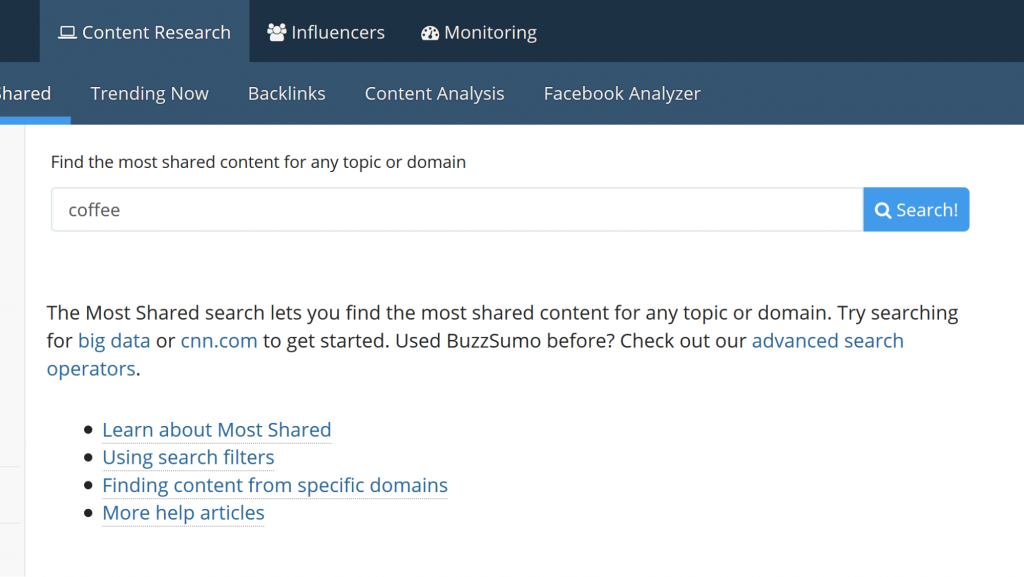
BuzzSumo automatically sorts content by total social shares (Facebook, Twitter, LinkedIn etc.).
If there’s one network that’s particularly important for your industry (for example, Pinterest is HUGE in the cooking niche), sort by popularity on that particular network.
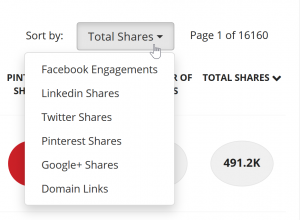
Next, take a look for any content ideas that fit with your site:
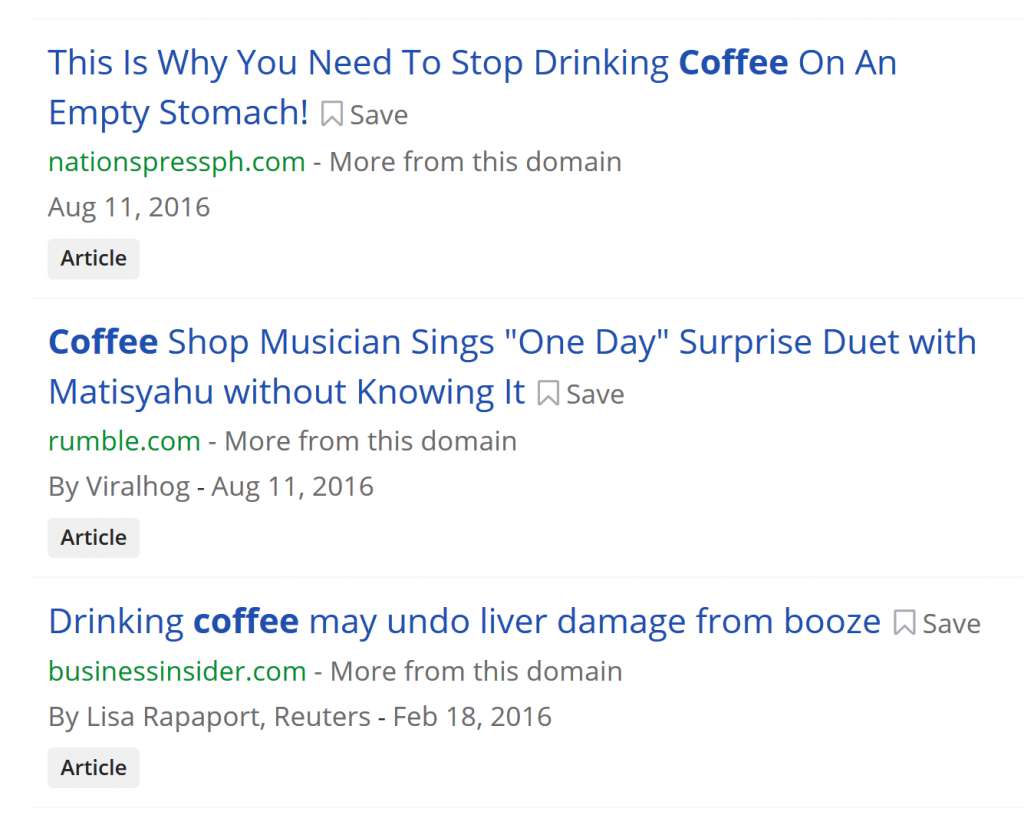
The great thing about BuzzSumo is that you can find a handful of promising content ideas after a 67-second search. In our coffee example, I found topics that could be turned into content titles like:
- 11 Reasons You Should Drink Coffee Everyday
- Your Coffee Pods’ Dirty Secret
- Coffee intake influences breast size, study says
- 21 Clever Uses for Coffee Grounds
By now you should have a spreadsheet or moleskin overflowing with content topic ideas.
Nice work 🙂
Before I show you what to do next, how about a little case study of this process in action?
Mini Case Study #1: On-Page SEO
After 4-months of struggling to get consistent traffic to Backlinko , I had my first little victory.
An infographic about on-page SEO:

It took quite a bit of outreach to get the word out (more on that later).
But it performed MUCH better than anything else that I’d published at that point on day 1.
Today, the infographic has thousands of shares:
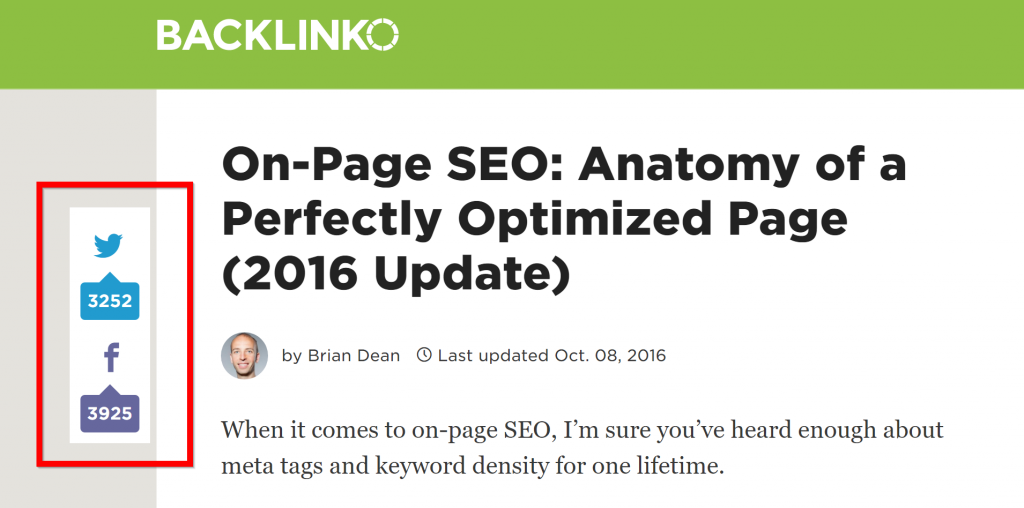
How did I do it?
Instead of guessing, I used a piece of proven content as my base: an infographic about on-page SEO published by Moz:

When I looked for popular content about on-page SEO, this infographic popped up over and over again.
This piece of popular content showed me that:
- People in the SEO space were still interested in on-page SEO
- People preferred a visual format for on-page SEO info
- People liked to read in-depth, text-based content that expands on the information in the visuals (which the original Moz post had)
So that’s exactly what I did with my piece of content. And because it was based on a proven framework, the content performed REALLY well.
To date, this simple infographic has generated nearly 400,000 unique visitors:

And unlike linkbait/BuzzFeed/NewsJacking style content, I continue to get 100+ visitors to that page every single day.
Step #2: Make Something (Much) Better
There’s this little quirk of human nature that I’m sure you’ve noticed yourself:
People are naturally attracted to the best.
Not 2nd best, not 4th best….the bar-none #1.
This is the “Skyscraper” part of The Skyscraper Technique.
At this point, you’ve found your tall skyscraper: a piece of content that soars above everything else out there.
Your next step is to bust out the heavy-duty cranes and add 15-stories to the top of it.
Here are 4-ways to do it:
Make It More Up-To-Date
Updating something is one of the easiest ways to add value to what’s already out there.
For some reason, people tend to let outstanding content rot…leaving it hopelessly out of date.
When you swoop in and make a cutting-edge equivalent, your industry will thank you in the form of links, social shares and traffic.
For example, I found this outdated article on the first page ranking for the keyword “coffee health benefits”:

This sentence pops out at me right away:
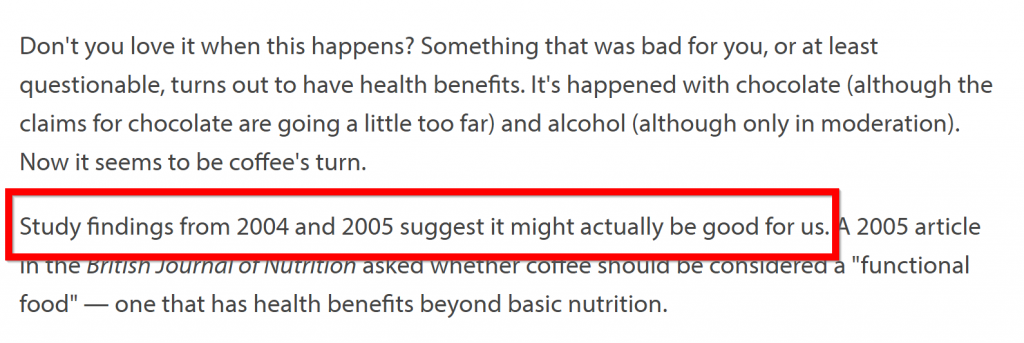
2004 and 2005? Looks like Haaavahd was too busy celebrating the 2004 Red Sox world series victory to update their article.
Despite being very out of date, this page has generated links from authority sites like The Huff Post and LiveStrong.com.
Needless to say, there’s been A LOT of coffee-related research over the last decade.
And a post that summarized the current state of coffee research would absolutely crush it…assuming you spent time promoting it (more on that later).
Make It More Thorough
Let’s face it: people today are super-busy.
And they don’t have time to go from post to post to post to learn how to save money on gas.
They want ONE resource that gives them everything they need to know…all in one place.
Back in 2010, the Paleo diet was blowing up in a big way. Thanks to pioneers like Mark Sisson, there was no shortage of awesome information about this increasingly-popular diet.
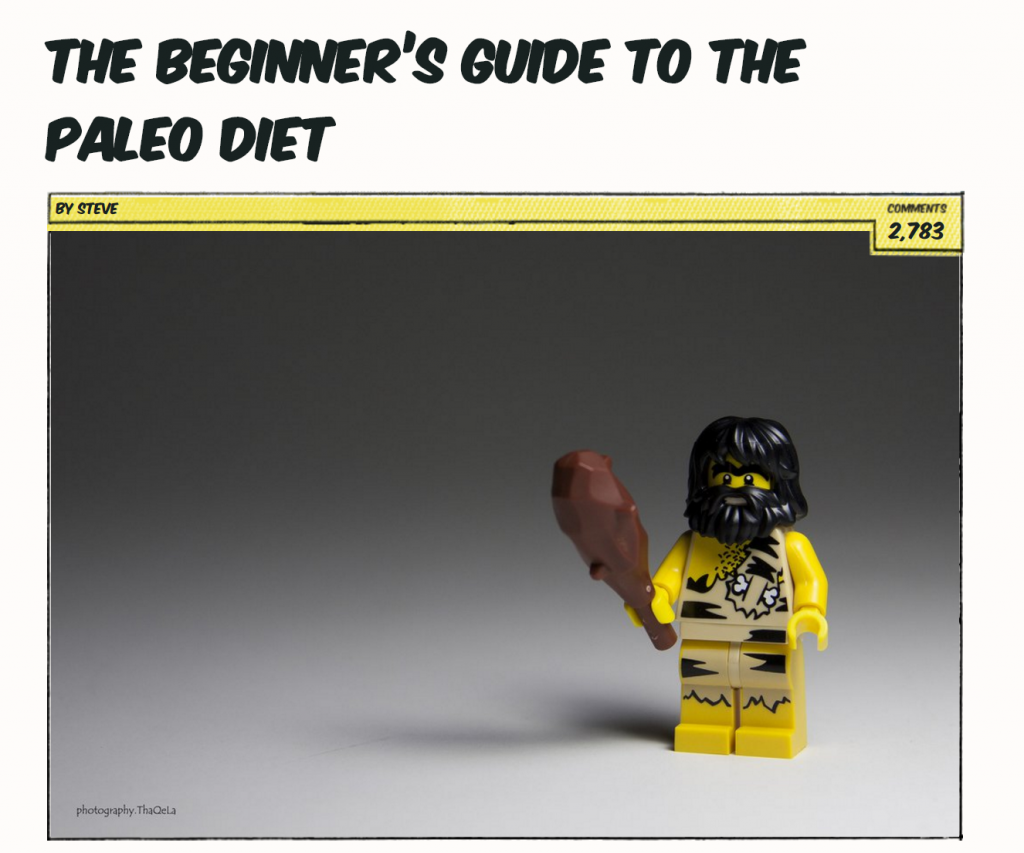
There was only one problem: You had to read 10 posts just to find out what you were supposed to eat for breakfast.
That’s when Steve at Nerd Fitness dropped an A-bomb on the fitness community with his 4,300 word beast: The Beginner’s Guide to the Paleo Diet.
To date that post has received a ridiculous 2,000 comments and 520 backlinks.
One stop shopping FTW!
Or how about our massive list of 355+ “Power Words” at Sumo? No more searching for 15 different articles on power words — this collection has ’em all.
Step Up The Design
There’s no other way to put this:
When it comes to content marketing, design is more important than the content itself.
Yes, you read that right: more important. In fact, it’s not even close.
Research has shown that there’s zero correlation between people reading and sharing content. Which means a good chunk of people share content without even reading it.
If they don’t read an article before hitting the tweet button, what makes them think “I need to share this”?
Three things: topic, headline and design.
So the better your content looks, the more people will share it.
Fortunately for you, most of your competitors probably sleep on design. Which is a HUGE opportunity for you.
Let’s take the email marketing niche as an example.
Most of the email marketing guides out there are simple-looking blog posts, like this:
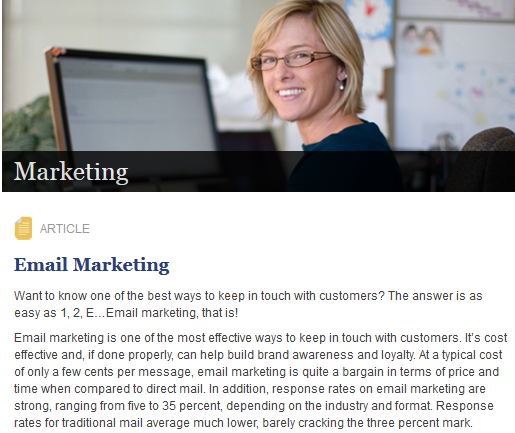
This design isn’t bad…but it’s not going to impress anyone.
On the opposite end of the design spectrum, CopyBlogger has a page about email marketing that’s as well-designed as a webpage can get:
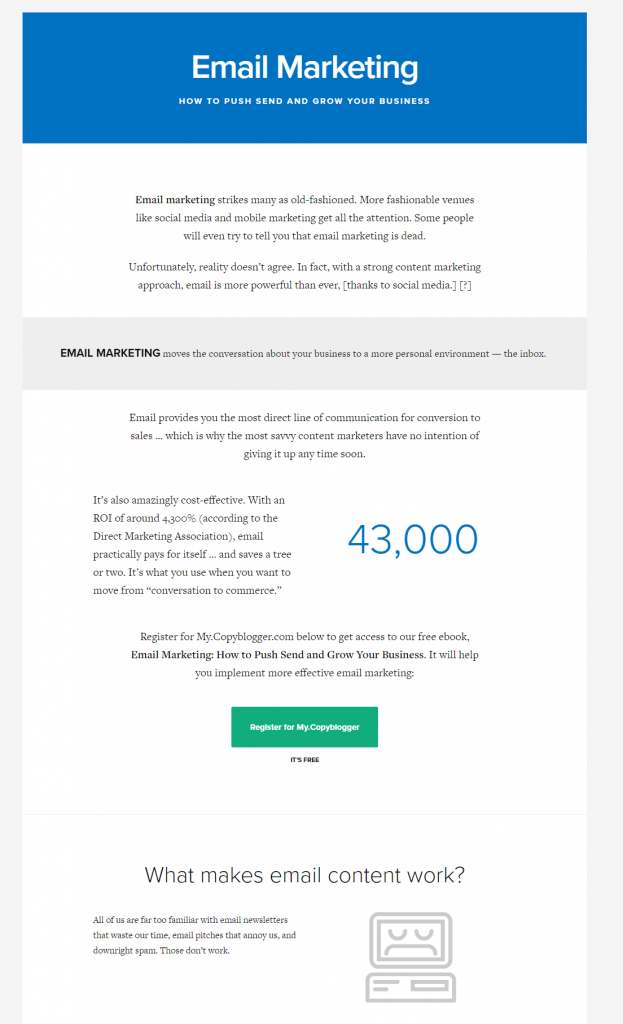
Although this page is more or less a squeeze page, its world-class design has brought in over 1.5k backlinks:
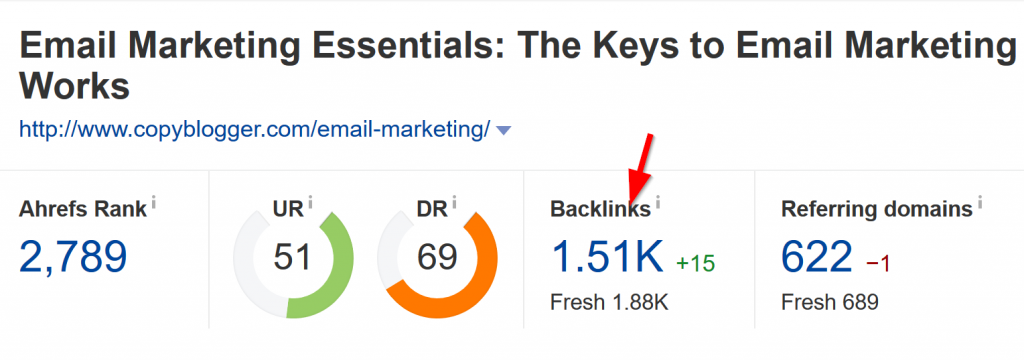
Or how about Neil Patel’s legendary series of Advanced Guides, like his Advanced Guide to SEO:

Design this good isn’t cheap. But you don’t necessarily need to drop 5-figures to tap into custom content design.
Even investing a few bucks for custom header images, which is something social media bloggers like Ian at Razor Social do for almost every post…

…or custom diagrams like this one from Runner Girl…

…dramatically increase the perceived value of your content.
As you can see, stepping your design game up doesn’t have to cost a fortune.
In fact, I drop $15-$20 per post on a nice custom image for every post at Backlinko:
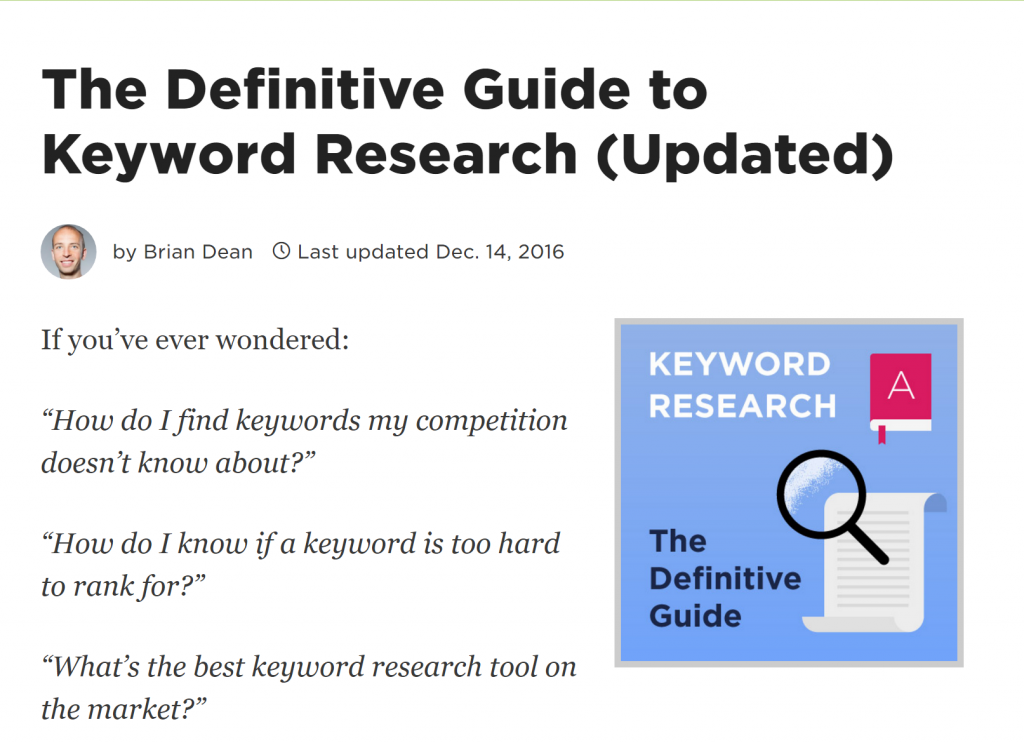
It’s the best $15 that I spend every month. This image makes my content look 10x more professional. And pretty images catch eyeballs in crowded Twitter feeds 🙂
But like most things, the more you put into your content’s design, the more you’ll get out of it.
Bottom line: quality design makes your content stand out and — as Derek Halpern taught the internet marketing community — seem more trustworthy.
Write Better
I know I just said that most people won’t read your content before they share it…
…but many will.
So it’s worth writing stuff that people, you know, actually enjoy reading.
Fortunately, most people write copy that’s drier than a piece of sandpaper in the desert.
That means — like with content design — there’s a HUGE opportunity for you to stand out with engaging copy.
(Neville’s Kopywriting Kourse helped me find my voice when I launched my blog. Highly recommended if your blog posts sound like a 9th grade history paper.)
Mini Case Study #2 : 200 Ranking Factors
Sometimes you’ll come across a piece of content in your industry that’s just BEGGING for a good old fashioned butt whooping.
That’s exactly what happened to me last year.
I was checking out the results for a few keywords related to Google’s mysterious ranking factors, like “Google ranking” and “Google’s ranking factors”.
This page by Vaughn’s 1 Pagers was ranking #1 for almost every single keyword that I searched for:
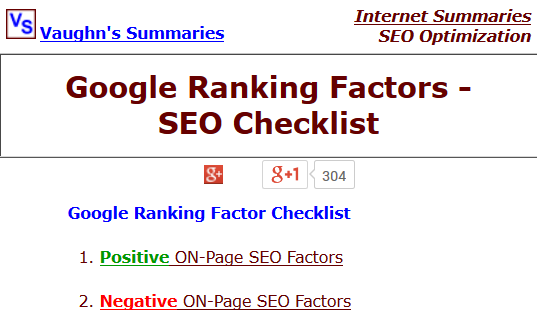
Vaughn’s guide was the most through summary of Google’s ranking signals online at that point. It listed an impressive 118 ranking factors.
The thing is, Google has confirmed on several occasions that they use over 200 ranking factors.
So where were the other 82?
Well that’s when I decided to roll up my sleeves and get cracking on a post that would document all 200.
The result? Google’s 200 Ranking Factors: The Complete List:
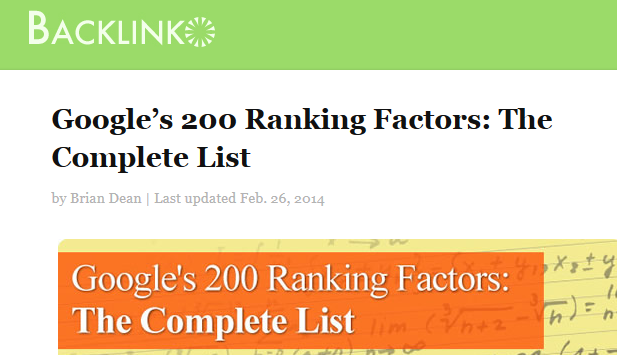
(That’s the original design. The updated one looks much better 🙂 )
This single blog post brings in 20k visitors per month:
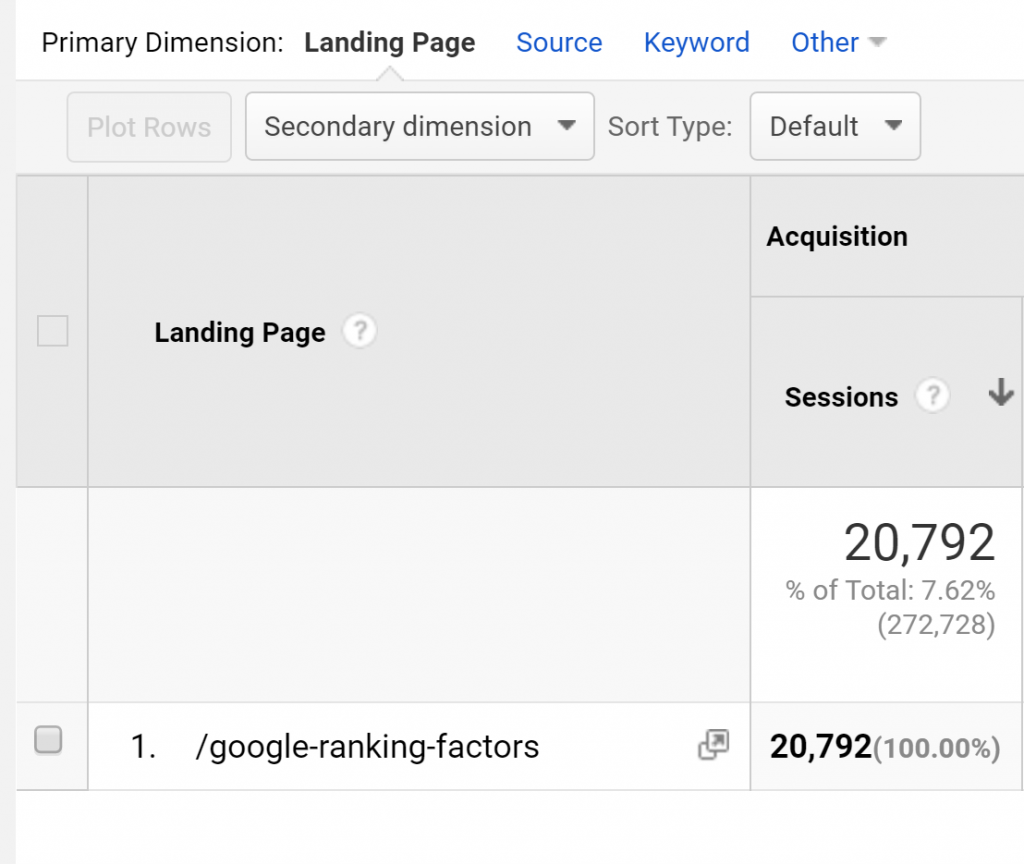
And generated over over 5k backlinks from 2k different sites:

Here’s How I Did It
As I said before, there are 4 main strategies for improving content:
- More updated
- More thorough
- Better designed
- Better written
One thing I didn’t mention is that:
The more you improve the content, the better results you’ll get.
In other words, you should beat what’s out there on every level that you possibly can.
And that’s one of the reasons my Google Ranking Factors post was so successful: it beat Vaughn’s post in almost every category.
Up To Date
Vaughn’s guide was first published in 2004…more than 10-years ago. He also hadn’t updated the post since 2012:
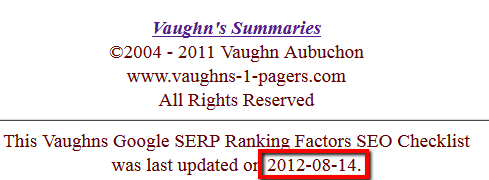
And when I dug through the content, I found something in desperate need of an update (for example, the page didn’t mention anything about Google Penguin under the “Google Updates” section).
In my post, I made sure to include lots of newer ranking signals (like social signals) while only including classic ranking signals (like PageRank) if they were still relevant.
That way, it would be readily apparent that my guide was more up-to-date.
More Thorough
This was A LOT harder than I thought it would be.
I knew that I wanted to hit all 200. That was simple enough. But let me tell you, it was very, very hard to pull off.
That being said, I was motivated by the fact that I knew that my super-comprehensive post would actually perform for me (thanks to the proven track record of Vaughn’s post).
After over 20 hours of work, I finally hit the 200 mark.
But simply naming 200 ranking factors wasn’t going to propel me head and shoulders above Vaughn. I needed to step my game up in a big way.
I noticed that Vaughn’s guide didn’t have a lot of explanation for ranking factors in his list:

So I made sure to include details and references for each and every ranking signal:
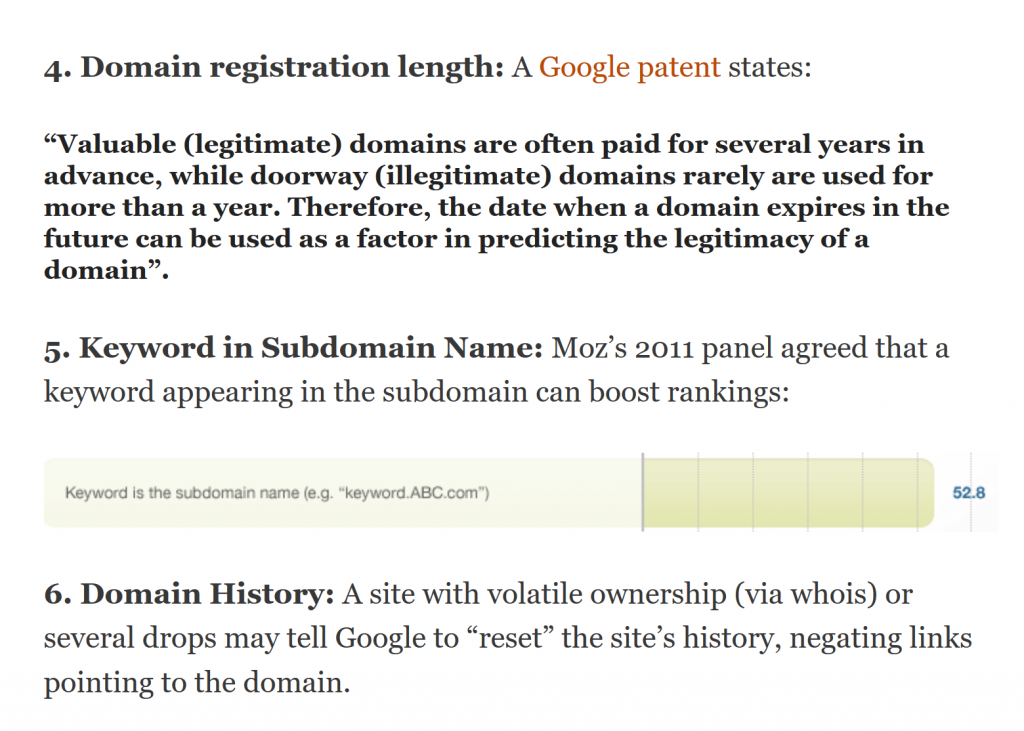
So if you have a competitor rocking the house with her list of 20 gluten free waffles recipes, you can beat her by publishing a list of 50…
…or publishing a list of 50 with unique images, insights and nutrition facts.
That extra level of “oomph” will leave no room for debate: you have the most thorough content.
Better Designed
As you’ve probably noticed from the screenshots so far, Vaughn’s guide looked like a 1998 Geocities page:

A simple blog post would have beat the pants out of this design.
But I decided to drop $20 on Elance and buy a few custom banners to break up the blocks of text:

These banners boosted the perceived value of my content without having to splurge on a massive design and coding project.
Here’s a template that you can use on Upwork or People Per Hour to get affordable custom diagrams:
I’m about to publish a blog post about YOUR TOPIC and need a set of 5 custom headers to break up the content.
I want something with a similar style to: LINK TO EXAMPLE. All of the banners should have the same style so they’re tied together.
Please place a bid and your turnaround time for the banners.
Better Written
Let’s face it:
A list of 200 algorithmic ranking factors can get really boring really fast.
Vaughn’s guide had very matter-of-fact descriptions of each ranking signal. For example, Vaughn describes “keyword density” with this:
![]()
Accurate…but not engaging.
I worked hard to make the post informative AND interesting. In other words, I wrote it less like an academic paper and more like an insanely-long blog post.
Step #3 : Get The Word Out
Here’s the deal:
If you want to get people to share and link to your content, you need to hustle to get the word out. Period.
In other words, the old “publish and pray” approach doesn’t work…unless you already have a massive audience like Seth Godin.
Fortunately, content promotion isn’t rocket science. It’s just a lot of hard work.
This is how you tap into it…
Find Likely Linkers
As the name suggests, Likely Linkers are people that are likely to link to your content (or at least share it on social media).
Here’s how to find them:
Find Passionate People
Let’s say that you just launched your very own travel blog.
You noticed that a competitor’s site crushed it with a post 2-years ago titled, “20 of the World’s Best Taco Stands”.
You followed steps #1 and #2 from this post and published a thorough, well-designed and up-to-date version of that taco stand article called “50 Taco Stands You Have to Visit Before You Die”.
Who are you going to reach out to?
Well, you could contact other travel sites. And you might get some love that way.
But you’re sometimes better off finding people outside of your niche that are passionate about that content’s topic.
For example, Noah may not be the first person that springs to mind when you want to promote something on a travel blog.
Although he’s interested in travel, millions of other people are too. Besides, Noah is best-known for validating business ideas, AppSumo and helping to build startups like Facebook and Mint.
But he’s the perfect person to reach out to.
Why?
Like most people, Noah has interests that lie outside of what he’s best known for:

Namely, the man loves tacos.
So if you mentioned him in a post about traveling AND tacos, he’d share your content in a heartbeat.
Here’s a real life example:
I recently published a guide to keyword research that was aimed squarely at SEOs and bloggers.
But I noticed another group that also had an interest in keyword research: fiction and non-fiction authors.
Most authors today realize that the best way to promote their book in the 21st century is to create a presence on the web. And that naturally lead to an interest in SEO.
So I emailed a blogger in the “here’s how to write and promote a book” niche and showed him my guide.
He loved it so much he mentioned it in his email newsletter, which brought in a few thousand high-converting visitors to my site:
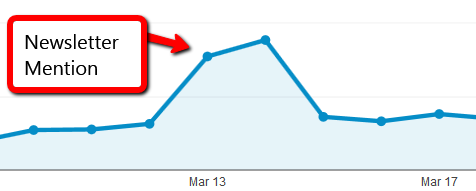
Not bad for a single email 🙂
Pre-Linkers
Want to find people that are very, very likely to link to your content?
Look no further than people that have already linked to similar stuff.
Because you have something objectively better than what already they’re linking to, asking for a link to your content is an easy sell.
How do you find who’s linking to your competitor’s content? Ahrefs. I like Ahrefs because it’s super easy to use and has an up-to-date list of links.
First, grab the now-inferior content’s URL and enter it into the tool.

Click on “backlinks” in the sidebar:
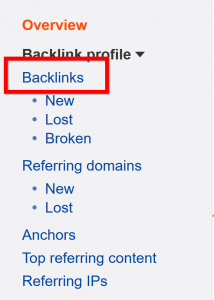
This will show you a list of sites linking to that page:
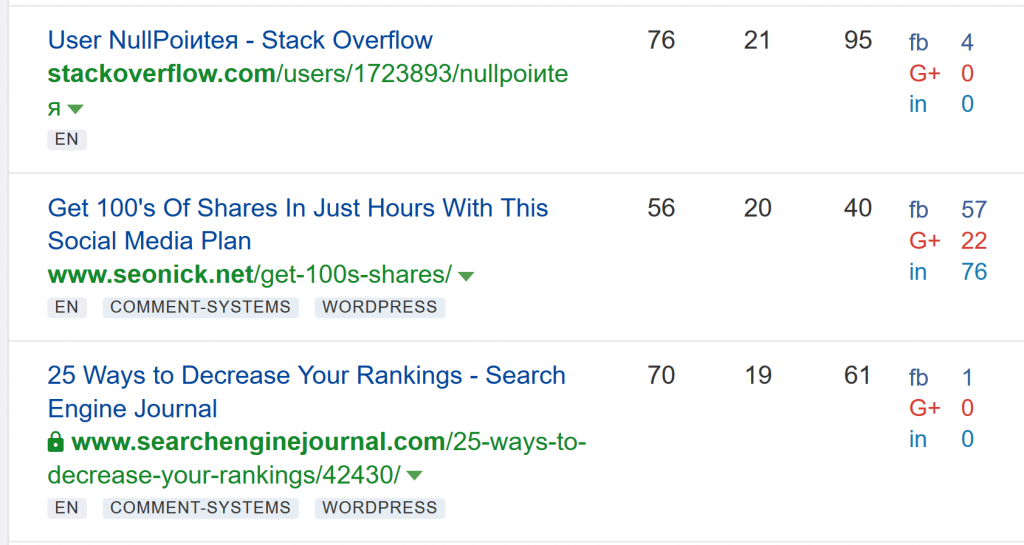
If you find a site that’s a good fit, send them this email script:
Subject: Quick question about SITE NAME
Hey NAME,
I was poking around SITE today and came across your article: ARTICLE TITLE.
Great stuff!
I noticed that you mentioned OUTDATED CONTENT. I also love that article.
In fact, it inspired me to create a more thorough and updated version:
YOUR URL
I’d be tickled pink if you’d consider mentioning it on your page.
Either way, keep up the awesome work with SITE NAME!
Cheers,
Your Name
A lot of people ask me, “What’s the conversion rate with this sort of outreach”.
Well it depends on…
- How much your content rocks the house
- Your content design
- Whether or not you reach out to the right person (for example, a multi-authored blog)
- What time/day you reach out to them (Tuesdays through Thursdays in the afternoon are best)
- How much time you take to personalize each email
- What industry you’re in (hippie niches like green living and music link out more often than corporate industries like insurance)
That being said, if you do everything right, you’re looking at a 5%-10% conversion rate. For some people that’s not worth the time and energy.
But to me, outreach is some of the highest-ROI time you’ll ever spend on your business. The links you get from outreach will send you referral and SEO traffic for years.
Thank You Emails
I’m sure you mention a few influential people in almost everything you publish.
But do you ever reach out to them and let them know about it?
Well, rather than hope that these influential people see and share your content, why not give them a quick heads up?
That’s where the Thank You Email comes into play.
It’s just a quick message to a) let the person know they’ve been mentioned an b) thanks them for their contribution.
Skeptical that a few emails can make a difference for your business? Right here on OKDork, Peep Laja recently revealed that these simple emails helped him grow his blog to 100k monthly visitors in less than a year.
I use almost the exact same short-and-sweet script that he does:
Hey NAME,
Just a heads up that I mentioned you here: URL.
Thanks for the awesome post 🙂
Cheers,
Brian
Easy, right?
Forums and Boards
Most marketers sleep on forums because they’re not some cool new hipster social network.
Well you know what?
Forums are still popular…really popular.
(If you think about it, Reddit is more or less a high-tech forum)
Industry forums are one of the few places you’ll find hundreds (and sometimes thousands) of people interested in your topic all in one place.
Just publish an ultimate guide to natural makeup removal?
Why not head over to MakeupTalk.com, where people discuss makeup on the reg:

Or how about the very active CruiseMates.com Forum, where people hang out to talk cruises (yes this is a real thing).

You get the idea: there’s a forum for every niche…including yours.
Now you can’t just create an account and drop links in every other thread. That spammy stuff will get you banned in a heartbeat.
That being said, you don’t need to be a thousand-post veteran, either.
Even a week-old account with a few helpful posts is enough.
Here’s how I used forums to promote a piece of content at Backlinko (and how you can do the same thing):
First, I used these search strings to find forums:
keyword forum
“keyword” + “board
keyword + “powered by vbulletin”
Next, I evaluated the forums based on a) how many people were online at any given time and b) the activity of the forum. You can find these two tidbits of info on the homepage of most forums:
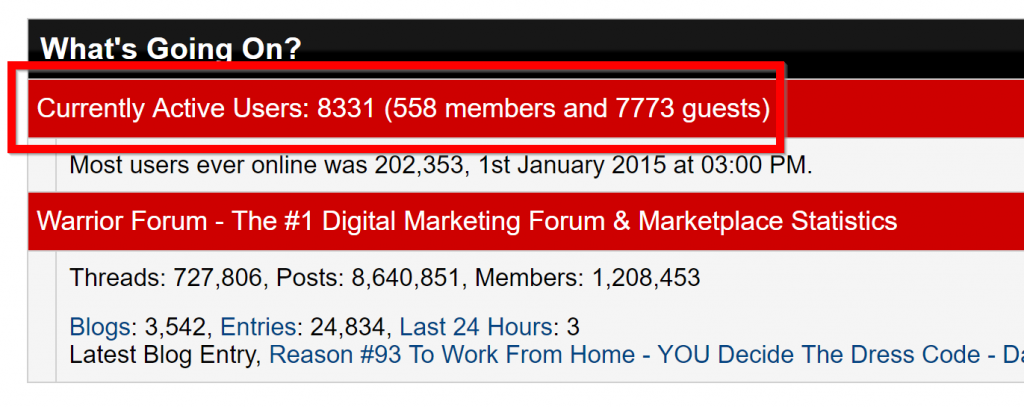
If I found that the forum had a few hundred people online at any given time AND lots of active discussions, I created an account.
Now that you have an account its time to participate adding tons of value.
There’s no shortcut here: answering people’s questions builds your reputation VERY quickly by users and moderators as a helpful member of the community.
Finally, create a new thread announcing your new piece of content.
I prefer to copy and paste a short and sweet version of the post into the thread itself. That way, you’re actually providing some meat to the userbase on the forum itself.
Just put a link at the top or bottom of the post that says, “If you’d like to read more, here’s a link to the full post”, like this:

I’ve done this a few times for blog posts at Backlinko. These forum threads brought in a rush of traffic before I had any audience to speak of. And they continue to drip traffic to my site every single day.
The Next Step
I hope you learned something new from my post. But more importantly, I want you to put this strategy into action.
When you do, you’ll actually be excited to publish something because you KNOW that it’s going to do well.
But that can wait a few minutes.
Right now I want to know what you think.
Have you tried reverse engineering content before? How did it work out?
Anything I missed?
Let me know what you think by leaving a comment.

214 responses to “Content Marketing for SEO Tutorial: How to Generate 400,000 Targeted Visitors”
Excellent article! You did a great job hitting on key ideas and solid actions to take to help grow my website content. Thank you for sharing so much freely!
Very well presented. Every quote was awesome and thanks for sharing the content. Keep sharing and keep motivating others.
It is an amazing post and you explained it in a detailed way. Nice to see this here. I will bookmark your blog for more details. Keep sharing new things like this.
Thanks a mil! Great stuff
Wow! Interesting, The tip on contacting websites based on interests and getting links from them is thorough and innovative. That’s some real meat I can dig into. I’m looking forward to putting it into practice. Thank you for the great post!
I get a lot of information from your post. Thanks, Admin for sharing your great ideas.
thanks for sharing i like your videos on utube
i have a question should we use same keyword on each webpage of the website ?
thank you in advance
Thanks for the helpful information.
great stuff.. I’m off to putting most of these techniques to action 🙂
Thanks so much for the helpful tips and advice!
Thanks Noah Kagan,
The post is full of useful information. I will use it a guide to blog writing. Thanks for sharing.
Brian Dean you are genius man thanks for sharing this awesome info with us. love to ready posts.. love to learn daily lots.. happy to subscribe your posts websites and Channel
I have tried this but gave up because I published and prayed for visitors (As you Mentioned) but now I’m boosted with your post..!! Brian, Neil and Noah you trio made my life very easy..! KUDOS…! Amazing article simple clear and literally spoon feeding,.. Keep boosting..!
That’s Awesome! I thought I could end of somewhere in middle of the post, but hadn’t. Learned a lot wanna get into action part now. Thank you Noah <3
Things have been changed a lot but I liked the idea of Flippa mining. It’s a great way to reverse engineer your competitors. I wish you update the article with latest tricks.
Awesome post. This is the true definition of quality content. People think that they put 1.5K words in a post and claim it quality but this is not the situation.
Post with 4K words, supported by related multimedia i.e pictures, youtube video, podcast, and infographic is the quality content of today.
In my opinion, if your post is EARNING backlinks, you have created quality content.
Hi Noah & Brian, this is a very useful post. I have been looking for this kind of information. I am sure it will help not only my business but also my customers grow!!!! I will start improving the SEO and content strategy. Regards
Hi Brian,
This is the 2nd time I stumbled upon this article and I read it through out again.
Things has changed a lot for you since you published this article but nothing has changed for this piece of content. It is still a pure gold.
You are simply genius.
I bookmarked this ‘coz I know I’ll be checking on this from time to time! Thanks!
Good post.
I think that I watched your YouTube video(s) explaining a few of these methods a few months ago. I am going to implement some of these. Thanks Brian!
Thanks alot Brian. I have read about this sky-scrapper elsewhere but it seems you have done a sky-scrapper of the sky-scrapper because… wow… you really do set out a full action plan with tools and strategy to get it done. What i read else-ware just defined the technique (the what) and you really went a lot more into the (why) plus with proof and most importantly a lot of (the how).
Really Love your long posts…. they really drive me crazy.. getting inspired from your techniques to build my new blog.
Hi Brian Dean,
Good Analysis regarding content ideas. simply an Awesome article, I have ever seen. I am a regular reader for your blog backlinko. Good job!
This information really helpful to me. Thank you.
Wow, I am amazed at all of the information you have included in this post. I have been reading many differnt blogs in the last few weeks and I must admit that your posts are rich in content and look very nice! Thanks so much for this valuable info! I just learn so many ways of getting content ideas, and all in one place, here on your blog!
Great Post Indeed!
These days, with so such of competition around, writing epic content is crucial. But it is sad to see, that most of the people are still not focusing on this most important factor.
As far as I know, catchy headline with problem solving content, can reach huge audience very quickly and can attract good quality Backlinks.
So, we really should focus on content.
Hey Noah,
These are great content tips, I will be sure to use a few if not all. And let you know how they panned out.
Thanks a ton!
Regards,
Ayushman Sen
Going To Create Content That Generates 400,000 Target Visitors Thanks To Brian Dean at Backlinko and Grant Cardone The 10X Rule
How Do You Like That Headline? LOL 🙂
Incredible. Awesome.
Great to know that such simple research can help you find great post tiles and write share worthy contents. Finding right title and share worthy topic takes lots of time anyways and then you have to do it every week.
Thanks for sharing this gem.
Brian and Noah,
This post indeed has the smell of epicness 🙂
I devour this like a choco croissant and I made a pdf as my constant guide on building up a successful blog.
Thanks for writing and sharing!
great content, i worked through it to check it out and i am very impressed. Thx for the step by step guide that us non techs can follow. shamefully, i feel like an expert now…LOL
Thank you very much for breaking down the Skyscraper Technique. I have tried to do this in the past but I have not gotten great results. I shall give it another go.
Cheers
Thanks for the post. It serves as a really useful resource for finding great content ideas. I’m starting work on some of these ideas right now 🙂
This is great. The sort of thing that once you read it you realize you knew it only you hadn’t put it together. I see that you spend, combined 10+ hours on an article (research, promotion, all that) and drop money on the content design… so it begs the question; are you making any revenue on your blogs with this method?
Ausgezeichnet!
Backlinko deserve at least 50 more bratwursts and a case of Lowenbrau.
This is what I’ve been looking for the past 2 months. Absolutely a game changer. I’d stopped doing online work to relax for some time. On coming back I knew I had to get back into the program as they say. Unfortunately the content I was able to find was the same ol’ same ol’
Boy I’m I not glad I decided spend more time online today. Then I read this and have to say, absolutely brilliant. Ooops I may be repeating myself.
Hi Noah, this is an amazing post thanks for the great advice, I find it extremely useful. I decided to apply a selection of this advice and techniques to my blog. Cheers, Claudiu.
To think I almost passed this up… This is a treasure trove for the freelance content provider. It is also something to chew on for the online platform builder that has an eye on content-based online platforms.
I feel richer (i.e. money-in-the-bank richer) just going through this (and the comments!). Now to take some action and build that wealth!
Wow! The tip on contacting websites based on interests and getting links from them is thorough and innovative. That’s some real meat I can dig into. I’m looking forward to putting it into practice. Thank you for the great post!
Thanks Noah and Brian! This is a really helpful post
Wow Brian, I feel like I see you everywhere on the internet on every single Marketing blog! How do you do it all?
This is the best blog I’ve come across on this topic. Thanks for sharing your knowledge! 🙂